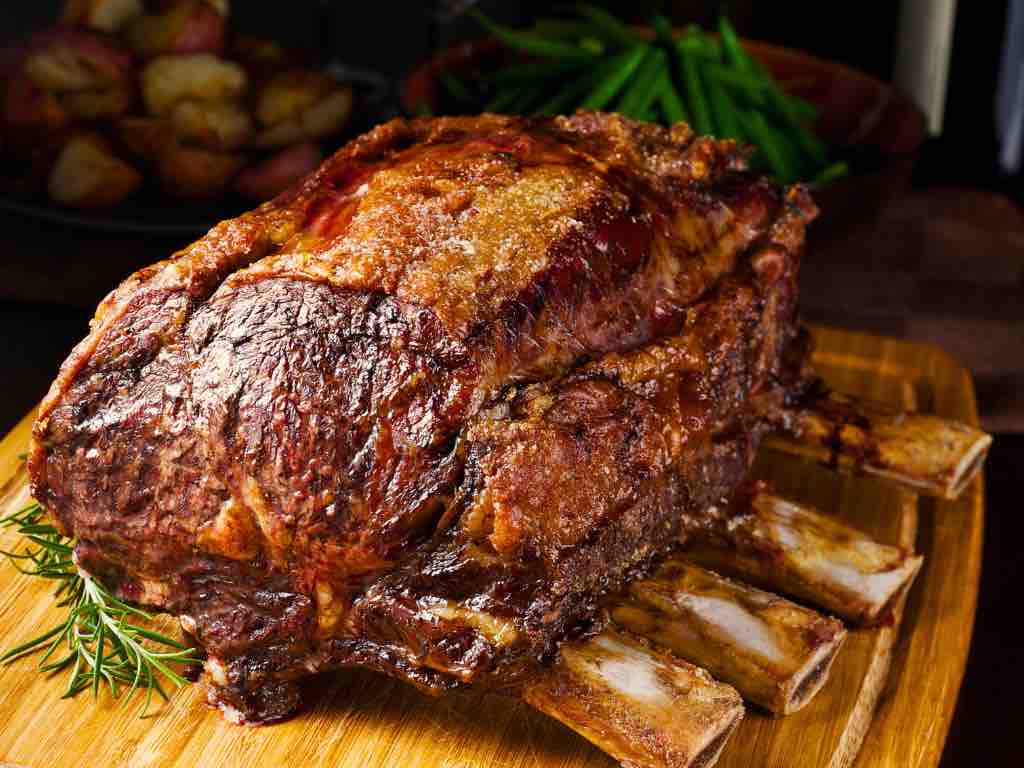Here’s a breakdown of these three premium cuts of beef — Prime Rib, Filet Mignon, and Bone-In Ribeye Steaks — so you can appreciate their unique qualities:
1. Prime Rib
- Cut: Comes from the primal rib section, typically including ribs 6-12. It’s a large roast rather than a single steak.
- Flavor: Rich, robust, and full-flavored due to the fat marbling throughout. The marbling melts during cooking, making it juicy and tender.
- Texture: Tender but with a bit more chew compared to other cuts like Filet Mignon. The fat adds a buttery texture.
- Best Cooking Methods:
- Roasting: Prime Rib is usually slow-roasted to achieve a medium-rare center with a flavorful crust. It’s often seasoned with garlic, herbs, and butter for extra flavor.
- Grilling: Some enjoy grilling or searing it to lock in the juices before slow cooking.
- Serving: Often served as a holiday or special occasion roast, sliced into thick portions, and paired with sides like mashed potatoes or creamed spinach.

2. Filet Mignon
- Cut: Taken from the smaller end of the tenderloin, part of the cow’s loin. It’s the most tender cut of beef.
- Flavor: Mild in flavor compared to fattier cuts. It’s known more for its tenderness than its intense beefy flavor, so it’s often paired with rich sauces or bacon-wrapped for extra flavor.
- Texture: Incredibly soft, often described as “buttery” because of how easily it melts in the mouth. It has minimal fat or marbling.
- Best Cooking Methods:
- Pan-Seared and Oven-Finished: Searing in a hot pan followed by finishing in the oven is a classic technique to maintain tenderness while creating a flavorful crust.
- Grilling: Filet Mignon can also be grilled over high heat to create a nice char without overcooking.
- Serving: Typically served as a small, thick steak (usually 6-8 ounces). Filet is often paired with sauces like béarnaise or topped with compound butter.

3. Bone-In Ribeye Steak
- Cut: Comes from the same section as Prime Rib but is served as an individual steak. The bone adds flavor and moisture, making it distinct from boneless ribeye.
- Flavor: Extremely flavorful, beefy, and juicy due to the high amount of fat marbling. The bone also contributes to the depth of flavor during cooking.
- Texture: Tender but with a satisfying bite. The marbling makes the steak succulent and rich.
- Best Cooking Methods:
- Grilling: Bone-in ribeyes are often grilled, where the heat sears the meat and creates a smoky, charred crust while leaving the inside tender and juicy.
- Pan-Seared: Searing the steak in a cast-iron skillet to create a crust, then finishing it in the oven works beautifully, especially if you baste it with butter and herbs.
- Serving: Served as a hearty, indulgent steak, usually 12-24 ounces. The bone adds visual appeal and often gives the steak a deeper flavor. Best served with simple sides like roasted vegetables or garlic mashed potatoes.

Summary:
- Prime Rib: Ideal for large gatherings; slow-cooked for a tender, juicy roast with a rich beefy flavor.
- Filet Mignon: The most tender and mild cut; perfect for individual steaks, often paired with sauces or cooked with added flavors.
- Bone-In Ribeye: For steak lovers who want a rich, beefy, and juicy experience; the bone and fat marbling give it incredible flavor.
Each of these cuts has its own distinct appeal, whether you want the ultimate tenderness, rich flavor, or a show-stopping roast.

